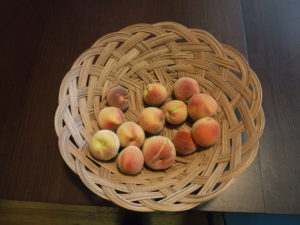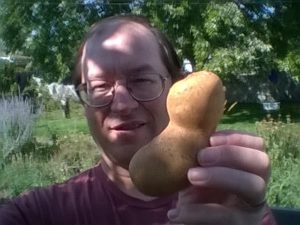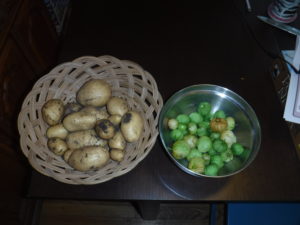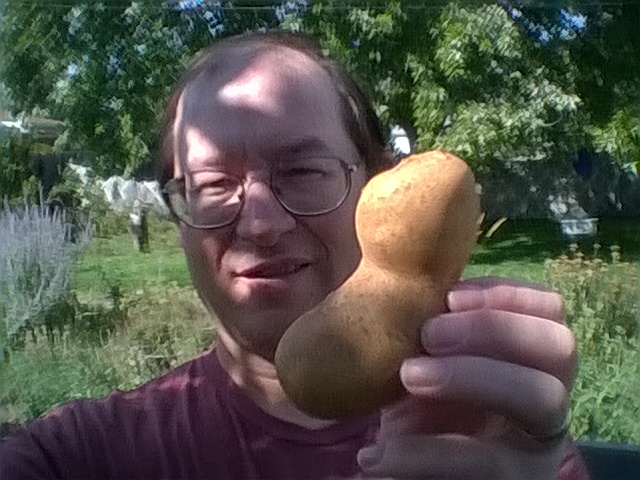I just harvested the last of my potatoes this year, and it occurred to me how happy it made me to grow potatoes. Everyone who has a garden should try their hand at growing potatoes. What makes it so great? I’m glad you asked.
It’s Easy
I always get excited about gardening in the spring, but I’m not good at keeping up the effort throughout the summer. I do a good job of planting my tomatoes inside and shepherding the seedlings through repotting and hardening and all that. But for the most part, I need a fire-and-forget crop. And potatoes fit the bill.
I plant the potatoes in the spring. Do a little weeding. Tracy runs drip lines from the garden network, and they’re done. Soon the plants are growing well enough that they outcompete the thistles and other weeds in the garden. They create dense foliage so they suppress the growth of new weeds and

get lots of energy for making potatoes. We do pinch the flowers off when they appear. But because they’re underground, you don’t have to keep chasing away the squirrels the way you do with some crops. Like peaches–the squirrels destroyed our peach harvest this year. It was looking to be a bumper crops–hundreds of peaches were weighing down the branches of the trees. But this is all we got. 🙁
Plus we can grow them in the shady side of the garden where nothing else seems to do well. So that’s a bonus.
I know, some people do more. A lot of people “earth up” around their potatoes, giving more dirt for the plants to grow potatoes in. And we did build a potato box the first year we planted–it’s 4x4x4 and had removable boards to let us keep adding dirt almost all the way to the top. But we’ve never done more than a couple additions, and we still get great yield from our potatoes–at least compared to our other crops. Maybe I’d be more dedicated to this if I were really counting on making it through the winter on my potatoes, but I count on making it through the winter on my writing for now . . . so, very little earthing up.
And it might be a pain if we started to get a bunch of beetles eating them. But so far they have fewer insect pests than almost any other crop.
It’s Fun
Not only is it easy growing potatoes, it’s fun, too. I enjoy every part of the process.

First, there’s the planting. Potatoes are the most fun crop to plant–you dig your holes and then you cut up the seed potatoes. The cutting makes it more fun–it’s not just playing with a knife, either: trying to decide how many plants you can get from each seed potato is a bit of a puzzle. So it’s cool.
Then, you watch them sprout, and because they have a good head start thanks to the tuber starch, they come up strong–lots of foliage right away, which is exciting. And, as I said, they grow into big, leafy plants, so they look good. They produce little white flowers that you get to kill, so that’s fun too.
But the most fun part about growing potatoes is the harvest. You get the shovel out and dig in the dirt, which I generally haven’t done that much of since the spring, so I’ve got a hankering. You really get in close, too, because you have to sift through the dirt looking for the potatoes.
It’s a treasure hunt! With most root crops, you pretty much know you’re going to get one root for one plant. With potatoes, you have no idea what you’re going to find. Now, you might end up with nothing (I’ve watched enough pirate movies to know that happens, but it’s part of the fun), but usually you end up with a treasure trove of goodies. And they’re all different sizes and shapes–it’s cool.
Volunteers!
When you’re harvesting, you are going to literally find some “small potatoes.” These aren’t just fingerlings–they’re really small. So you leave them

behind. Plus, you might not find all the potatoes, so you have some that just sit in the ground all winter, and then come up on their own. Volunteer potatoes are great. They get an early start on the year, so they can make for an early harvest, especially if the weather delayed your planting in the spring.
These are free potatoes–you did even less to take care of these plants, and yet you can get a good yield from them. This year, we got almost five pounds of potatoes from our volunteer plants–about a third of our total harvest.And, as I said, they were our early harvest. Plus, they were the variety we planted last year, which I liked a little better than the kind we found this year, so that’s an extra bonus.
It’s a Great Mealtime Rescue Option
With a lot of garden vegetables, you have a few recipes you like to use them in every year, but when it’s bumper crop time, you might struggle to find ways to use them. That’s not the case with potatoes. You can always figure out ways to use potatoes, either as a side or as a main dish. There are dozens of easy recipes that come to mind for using potatoes, so you never have to worry about using them up.
Best of all, potatoes can save you if you’re in a jam and don’t know what to make for dinner. Many potato recipes require nothing more than the things you probably already have on hand. You don’t need exotic ingredients or special tools to make a potato-based meal. Not sure what you want to eat? There’s always potatoes. It’s not like you can literally go out back and dig up dinner, but potatoes make a more substantial base for meals than anything else I grow (partly because my corn never seems to grow all that well).
Commercial Potatoes Are Loaded with Pesticides
This isn’t a major factor to me, but it’s certainly a consideration. I don’t garden to reduce my pesticide exposure–I consider that a side benefit. But with potatoes, it’s a bigger deal. Potatoes regularly make the “Dirty Dozen” crops most laden with pesticides. These pesticides have been linked to personal risks, including cancer, neurological damage, hormone disruption, and reproductive impact. The most common pesticide found on potatoes (it’s on about 80% of all that were sampled) is a threat to bees and other insects.
How likely is it that we experience harm from pesticides found on commercial vegetables like potatoes? The science is unclear to me. There’s a lot of theoretical harm, and we’ve documented harm from heavy exposure to some of these pesticides.But is prolonged exposure to a low does capable of causing the same type of harm? It’s hard to say.
That said, it makes sense to reduce exposure to chemicals that have been linked to specific risks. So if you can buy and consume fewer bags of pesticide-laden potatoes, that’s a win.
Why Not Grow Potatoes?
For all the good reasons to grow potatoes, there are also some things you should not expect from your potato crop. Most importantly: don’t expect your home-grown potatoes to be cheap. Store-bought potatoes are already cheap, and they get even cheaper when they’re in season. Even with a good harvest, you’re unlikely to pay less for seed potatoes than you would pay for commercially grown potatoes. Of course, you could always use commercial potatoes as your seed potatoes. I never make this my primary strategy, but if I’ve got a few that are starting to sprout, I throw them in the ground with the other seed potatoes, and it works well enough. And though this may introduce some pesticides to your home-growns, it’s still likely to be much less than if you were actually buying potatoes from the store.
So, yeah, on the whole, I’d recommend growing potatoes. After tomatoes and hops, they’re probably my most satisfying garden plant. I dig ’em!

